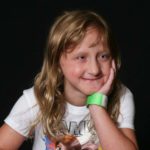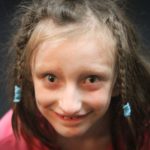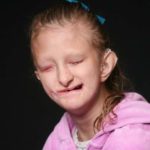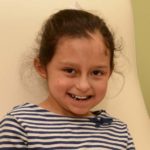Synonyms
- Focal Dermal Hypoplasia
- Goltz-Gorlin Syndrome
- FODH; FDH
The clinical findings of Goltz syndrome can overlap with those of other ectodermal dysplasia syndromes and are variable in presentation. This complicates diagnosis and further characterization of these disorders.
Goltz syndrome is a rare genetic condition characterized by involvement of the skin, skeletal system, eyes, and face. Skin manifestations present at birth include thin skin and areas of missing skin; fat nodules in skin manifesting as soft, yellow-pink nodules; and pigmentary changes. Wart-like papillomas of the skin and mucous membranes may appear later. The nails can be ridged, malformed, or small; hair can be sparse or absent.
Limb malformations include absence of digits, webbed digits and split hand/foot. Developmental abnormalities of the eye can include small or absent eyes, notching of the iris and retina, and tear duct abnormalities. Craniofacial findings can include facial asymmetry, notched skin of the nose, cleft lip and palate, and pointed chin.
Occasional findings include dental anomalies, abdominal wall defects, diaphragmatic hernia, and kidney system anomalies. Psychomotor development is usually normal; some individuals have cognitive impairment. Individuals may be mildly, moderately, or severely affected. Features are often asymmetrical, with the right and left side of the body being affected differently.
Major Findings: Need Three from Skin/Nails and One from Limbs to Make Diagnosis
Skin/Nails
- Congenital patchy skin aplasia (95% of individuals) evidenced by thin or absent areas of skin that are linear on the extremities and circular on the trunk, and appear as depressed regions of pink or white color
- Congenital dark or light patches of skin color, often also in linear pattern
- Congenital nodular fat herniation (60%-70%), evidenced by soft, yellow-pink nodules on the skin (which represent fat nodules in the skin) that are typically seen on the trunk and extremities
- Congenital ridged, malformed, or small nails (80%-90%)
- Telangiectasias (~80%) (thread-like red lines or patterns on skin–may be seen on the face, trunk, and extremities)
Limbs
- Syndactyly (70%-90% of individuals) joining or webbing of ≥2 fingers or toes, occurring variably on one or more extremities
- Ectrodactyly (75%), a split hand/foot malformation that may occur on one or more extremities
- Oligodactyly (20%-40%) – <5 digits on a hand or foot, which may be seen in one or both hands or feet. Central digits are more frequently involved.
- Transverse limb defect (15%) – Congenital absence of the hand, wrist, forearm, or elbow with no distal remaining portions, including acheiria or hemimelia.
- Long bone reduction defect (50%-80%) – shortening of the long bones in one or more extremities
Minor Findings: Occur, but Not Necessary for Diagnosis
Additional common features not included in the diagnostic criteria but supportive of the diagnosis include the following.
Ectodermal Manifestations
- Patchy absence of hair of the scalp (80% of individuals) or wiry hair (65%)
- Wart-like papillomas (65%) of the skin and mucous membranes (including in the mouth, nose, larynx, esophagus, vaginal lining, and/or rectal lining)
- Dental abnormalities including enamel defects/grooving (65%), peg teeth (50%), or missing teeth (80%)
- Photosensitivity (40%)
- Pebbled skin texture (58%)
- Hair shaft abnormalities (80%-90%)
Eye Manifestations
- Iris notching (50% of individuals)
- Chorioretinal notching (60%)
- Small eyes (45%) or absent eyes (5%-10%)
- Cataracts (10%)
- Involuntary movement of the eye (30%) or crossed/wandering eyes (20%)
- Tear duct obstruction
Skeletal
- Scoliosis (curvature of the spine)
- Small collar bones and/or ribs
- Giant cell tumors of the bone
- Linear markings on the bones on X-ray
Craniofacial
- Facial asymmetry
- Notching of the sides of the nares (dent in the side of the nose)
- Small, pointed chin
Dental
- Missing teeth, abnormally-shaped teeth, extra teeth
- Abnormal enamel
Gastrointestinal and Nutrition
- Short stature (65%)
- Poor weight gain (77%)
- Oral-motor, chewing and swallowing problems (41%)
- Gastroesophageal reflux (24%)
- Constipation (35%)
- Abdominal wall defects (rare)
- Hernia of intestines into chest (rare)
Kidney and urogenital
- Small labia minora (fat pads on the side of the vaginal opening) in most females
- Rare kidney structural problems
Cognitive and Psychological
- Development and intellectual ability normal in most (80-85%)
- Cognitive disability (15-20%)
- Behavioral problems (20%)
- Emotional lability (40-50%)
- Withdrawn behavior (65%)
Neurological
- Seizures (rare)
- Sensorineural hearing loss (rare)
Obstructive sleep apnea (93%)
Diagnosing Goltz Syndrome
Diagnosis can be made be a clinician. Genetic testing is available.
Causes of Goltz Syndrome
Goltz syndrome is caused by a change (mutation) in a gene called PORCN.
Genetic Testing
Testing is available for Goltz syndrome.
Goltz Syndrome Inheritance
Goltz syndrome is inherited as an X-linked dominant disorder. See explanations below.
Occurrence
- Rare disorder (actual frequency in any population is unknown)
- Most cases (~95%) are isolated (sole occurrence in the family)
- A few familial occurrences have been published, almost exclusively female-to-female transmission
- Most recognized affected individuals (~90+%) are girls.
- A few (~10%) males have been affected; those males are all new genetic events (new mutations); males are usually more mildly affected than females.
- Affected males have a chance of having a daughter who is more severely affected.
- No father-to-son transmission has ever been reported.
- Therefore, the altered gene is considered “lethal” to a male pregnancy (fetus); essentially all of whom die in the womb and only affected females survive to be born. This is termed “x-linked dominant inheritance with male lethality” or “x-linked dominant lethal”.
- The few identified males are “mosaics.” They have some normal genes and some populations of a mutation in the Goltz gene. They are milder than affected females and are able to survive, some long enough to grow up to have (more severely) affected daughters.
Family Perspectives
- Read about Jodi and Michael Watts’ experience in having a daughter affected by Goltz syndrome.
- Read about Jordan Buerman, a talented gymnast who also has Goltz syndrome.
- Learning More About Papillomas and Goltz Syndrome









